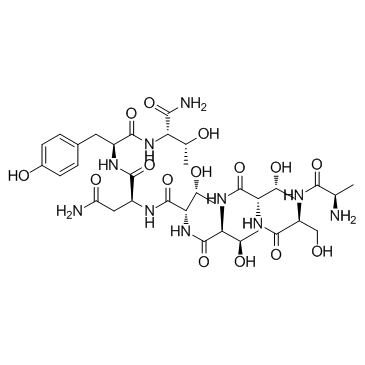(D-Ala1)-Peptide T amide

(D-Ala1)-Peptide T amide structure
|
Common Name | (D-Ala1)-Peptide T amide | ||
|---|---|---|---|---|
| CAS Number | 106362-34-9 | Molecular Weight | 856.87700 | |
| Density | 1.415g/cm3 | Boiling Point | 1514.3ºC at 760mmHg | |
| Molecular Formula | C35H56N10O15 | Melting Point | N/A | |
| MSDS | USA | Flash Point | 869.6ºC | |
Use of (D-Ala1)-Peptide T amideDAPTA is a synthetic peptide, functions as a viral entry inhibitor by targeting selectively CCR5, and shows potent anti-HIV activities. Sequence: Ala-Ser-Thr-Thr-Thr-Asn-Tyr-Thr-NH2. |
| Name | dapta |
|---|---|
| Synonym | More Synonyms |
| Description | DAPTA is a synthetic peptide, functions as a viral entry inhibitor by targeting selectively CCR5, and shows potent anti-HIV activities. Sequence: Ala-Ser-Thr-Thr-Thr-Asn-Tyr-Thr-NH2. |
|---|---|
| Related Catalog | |
| Target |
gp120BaL/sCD4-CCR5:55 pM (IC50, in Cf2Th/synR5 cells) gp120CMCM235/sCD4-CCR5:0.32 nM (IC50, in Cf2Th/synR5 cells) |
| In Vitro | DAPTA (1 nM) inhibits HIV-1 replication in monocytes/macrophages (M/M) by >90%. DAPTA blocks HIV entry and prevents HIV-1 infection. DAPTA reduces CCR5 mAb binding in human primary macrophages. DAPTA potently blocks R5 gp120-mediated neuronal apoptosis. DAPTA is even more potent in preventing neuronal apoptosis than the CCR5 antagonist TAK-779[1]. DAPTA potently inhibits specific CD4-dependent binding of gp120 Bal (IC50 = 0.06 nM) and CM235 (IC50 = 0.32 nM) to CCR5. DAPTA (1 nM) blocks formation of the gp120/sCD4 complex with CCR5. DAPTA inhibits the binding of gp120BaL/sCD4 to CCR5 (Cf2Th/synR5) cells with IC50 of 55 ± 0.08 pM[2]. |
| Kinase Assay | A novel FITC-labeled tracer from soluble gp120 proteins (25 g/mL) is prepared using a Fluorescent protein labeling kit, according to the manufacture's instructions. Uncoupled FLUOS is removed by Sephadex G-10 column filtration. The molar ratio between FLUOS-labeling molecules and protein is from 3.5 to 4.5 fluorescence molecules per molecule of gp120. The concentration of fluorescent-labeled proteins is measured by Bradford assay and Western blotting by using calibrating amounts of soluble molecules with known concentration. Binding assays are performed in binding buffer, in final volume 100l. Binding is carried out for 1 h at 37°C in 96-well filter plates. Unbound-labeled proteins are removed by rapid vacuum filtration and ishing using a 96-well plates manifold. Each binding mix is washed five times with 0.2 mL (total volume of 1.0 mL/well) cold ishing buffer (50 mM HEPES, pH 7.4, 150 mM NaCl, 5 mM MgCl2, 1 mM CaCl2). Filters are counted with a fluorescent plate reader at 495/530 nm. |
| References |
| Density | 1.415g/cm3 |
|---|---|
| Boiling Point | 1514.3ºC at 760mmHg |
| Molecular Formula | C35H56N10O15 |
| Molecular Weight | 856.87700 |
| Flash Point | 869.6ºC |
| Exact Mass | 856.39300 |
| PSA | 437.28000 |
| Vapour Pressure | 0mmHg at 25°C |
| Index of Refraction | 1.596 |
| Storage condition | -20°C |
| Personal Protective Equipment | Eyeshields;Gloves;type N95 (US);type P1 (EN143) respirator filter |
|---|---|
| RIDADR | NONH for all modes of transport |
| WGK Germany | 3 |
|
Octapeptides deduced from the neuropeptide receptor-like pattern of antigen T4 in brain potently inhibit human immunodeficiency virus receptor binding and T-cell infectivity.
Proc. Natl. Acad. Sci. U. S. A. 83 , 9254, (1986) The differentiation antigen T4, present on the helper/inducer subset of T lymphocytes, is thought to serve as the receptor for the human immunodeficiency virus (HIV). We find that a 60-kDa protein, im... |
| L-ThreoninaMide,D-alanyl-L-seryl-L-threonyl-L-threonyl-L-threonyl-L-asparaginyl-L-tyrosyl |
| D-ALA-SER-THR-THR-THR-ASN-TYR-THR-NH2 |
| D-Ala-Ser-Thr-Thr-Thr-Asn-Tyr-Thr amide acetate salt |
| D-Ala-L-Ser-L-Thr-L-Thr-L-Thr-L-Asn-L-Tyr-L-Thr-NH2 |
| H-D-ALA-SER-THR-THR-THR-ASN-TYR-THR-NH2 |
| Octapeptide T |
| D-ala-ser-thr-thr-thr-asn-tyr-thr amide acetate |
| (D-ALA1)-PEPTIDE T AMIDE |
| Adaptavir |

